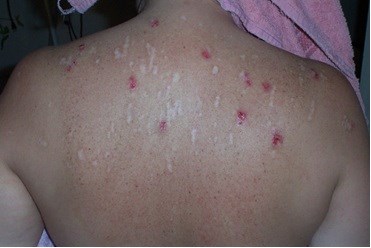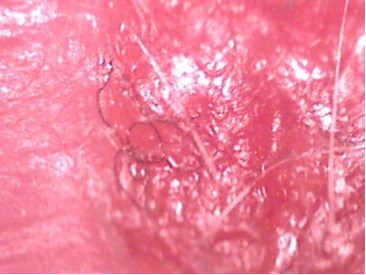Morgellons Disease
Introduction
Over the years, there have been an increased number of publications debating the presence of a new medical condition referred to as "Morgellons Disease" (MD). The term refers to a paper written by Sir Thomas Browne in 1674 entitled De vermiculis capillaribus infantium. In this monograph, he describes children who broke out in "harsh hairs on their backs", using the name "Morgellons" as a reference to mouscouloun, the hook that is attached to the end of a spindle. The name Morgellons was then used by Kellett in 1935 and again by Emslie-Smith in 1946. The term found its modern use when Mary Leitao founded the Morgellons Research Foundation in 2002. She discovered the article by Browne while looking for a cause for her 2 year old son's unexplained medical condition. She first found fibers in his skin while examining them with her home-bought microscope. Her two teenage children subsequently developed symptoms, though by then, she had begun to develop a nationwide network of concerned patients and researchers. Although some believed that Leitao suffered from Munchaesons by proxy, others with similar symptoms were grateful for an advocate.
Descriptive Studies of Morgellons Disease
Publications describing this syndrome began in 2005, with basic scientists and primary care physicians dominating the conversation. Larger descriptive publications were released, providing a case definition for Morgellons Disease in 2007 (see Table 1) and a case series of 122 patients in 2010.
Publications from dermatologists have been more hesitant to use the new term. Many argue that patient-derived diagnostic terms should not be used to describe conditions which have not yet been validated by medical evidence. Furthermore, the Morgellons website describes the use of antimicrobial medications, which patients may unsafely order online without physician supervision (Reichenberg, personal observation, 2011), and discourage patients from trying psychiatric drugs for the treatment of their disease.
In 2012, the CDC published the results of a federally-funded study on Morgellons disease. Of the 115 patients studied, there was no detectable infectious agent found. Unidentified material was further analyzed by scanning electron microscopy with energy dispersive X-ray analysis; most materials collected were composed of cellulose: 63% had evidence of clinically significant somatic complaints, and 50% had drugs of abuse detected in hair samples. The authors explained that they were unable to conclude "whether this unexplained dermopathy represents a new condition… or wider recognition of an existing condition such as delusional infestation, with which it shares a number of clinical and epidemiologic features."
Criticisms of the study focus on the recruitment biases in that patients asked to participate were already labeled as 'delusional.' They also limited patient enrollment to a specific geographic area, and excluded patients whose symptoms had existed for grander than 3 months. Indifference to the findings of the CDC, Middelveen, and colleagues analyzed tissue from Morgellons patients and found tissue from Morgellons patients and found keratin and collagen filaments.
Proposed Causes for Morgellons Disease
There have been a few publications that have looked for an organic cause of the condition. Polymerase Chain Reaction techniques have demonstrated spirochetes (Borreliaspecies) in the tissue of patients with MD, though these tests were not approved by the FDA and the organisms may have been part of normal skin flora.
Some researchers suggest that MD may be a chronic infection with Borrelia species, or a form of chronic Lyme disease. However, the concept of chronic Lyme disease is itself controversial, with a recent international consensus statement concluding that chronic infection with Burgdorferi not supported by carefully executed laboratory analyses or by controlled treatment practices.
One recent study proposed that patients complaining of "bugs" may be different than those who complain of "fibers." They found 'Bug' patients to be more likely to fit the classic description of delusional disorder; whereas 'fiber' patients may have a dysethetic syndrome - a chronic pain disorder akin to chronic fatigue or fibromyalgia (dubbed "Princess and the Pea" patients due to their hypersensitivity to pain and inability to ignore trivial stimuli).
Treatment of patients who complain of fibers in their skin
The most important first step in the approach to these patients is to determine if they have any other medical diagnoses or treatable skin diseases. Skin superinfection is common, as is contact dermatitis from applied substances. Patients with similar complaints may actually have schizophrenia, skin picking disorder, somatic symptom disorder, lichen planus, dementia, drug addiction, or contact dermatitis. It is important to do a thorough history and skin examination, and a detailed review of systems can pick up details that an interview may miss. Laboratory testing should be guided by these findings.
Practitioners who treat MD with antibiotics report improvement of symptoms, but no blinded studies have been published. Some describe successful treatment of patients with MD using pimozide and risperdal, drugs commonly utilized in patients with delusions of parasitosis. The author has previously discovered some success treating 'fiber' patients with antipsychotics, but more lately has shifted to using antidepressants such as citalopram when depression and anxiety predominate. This approach focuses less on a cure for the 'fibers' and more on improving quality of life and reducing patient suffering.
Conclusion
The term Morgellons is, in itself, controversial, as are the proposed treatments for the condition. After the publication of the CDC study, many physicians have come down strongly in favor of a psychiatric etiology. Basic science research continues to produce data that may imply an infectious etiology. Regardless, all parties agree that these patients are suffering, and should be offered medical and psychosocial treatments when indicated.
Table 1: Case Definition for Morgellons Disease as provided by the Morgellons Research Foundation
- Skin lesions accompanied by intense itching
- Crawling sensations on and under the skin, often compared to insects moving, stinging, or biting (cutaneous dysethesia)
- Colored Fibers in and on the lesions (or 'fuzz balls' or 'black specks')
- Fatigue significant enough to interfere with daily activity
- Musculoskeletal pain
- Inability to concentrate and difficulty with short term memory "brain fog"
- Behavioral changes
(Adapted from Savely VR, Stricker, RB. Morgellons Disease: the mystery unfolds. Expert Reviews in Dermatology 2(5) 585-591 (2007))
Figure 1

Figure 2

